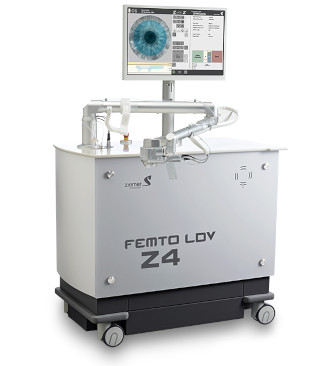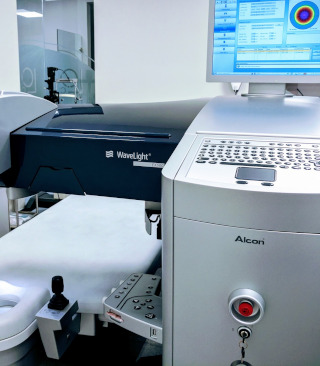What equipment is used at LCC for refractive surgery?

FEMTO-LDV Z4
At LCC, we are proud to offer the latest technology for custom vision correction. A ziemer femtosecond laser is used to make LASIK flaps.
The LDV Ziemer femtosecond laser is an advanced low energy laser that allows for 3D custom corneal flaps (adjustable flap thickness from 90-160 microns, and adjustable diameter from 6.5-10mm).
These special 3D laser flaps create an advanced “self centering” flap which makes the procedure safer.
The Ziemer femtosecond laser has lower energy settings, and higher repetition rates than other femtosecond lasers, which allows for faster visual recovery.
Once the flap is made, an excimer laser is used to sculpt the glasses prescription onto the cornea.

Wavelight EX500
At LCC, we are proud to offer the new Wavelight EX500 excimer laser, the world’s fastest excimer platform, offering the widest range of customized laser treatments.
The EX500 uses WAVENET to link all diagnostic equipment directly to the laser, so any custom treatment plans are directly sent to the laser (no risk of transcription errors).
The EX500 maps to your eye and adjusts for cyclotorsion (rotation of the eye when you lie down).
This “cyclotorsion adjustment” is critically important if you have astigmatism, as the ablation needs to be placed exactly at the correct axis. The EX500 is also able to perform custom “topography guided” treatments to correct for higher order aberrations on the cornea.
The WAVELIGHT EX500 maps to an individual person’s eye, and track eye movements during treatments with 2 milliseconds of latency; in other words, the laser is able to track your eye, faster than you are able to move it.
What are the risks with LASIK?
It is the most widely performed surgery in the world (over 40 million procedures in the last 20 years)
LASIK technology has progressed over the past 20 years, similar to how computer technology has advanced. LASIK is a very safe procedure, but does come with some risk, as any surgical procedure.
Intraoperative
- Flap problem - this is very rare with the “bladeless approach”
- Decentered ablation - very rare with modern excimer lasers
Postoperative
- Undercorrection or overcorrection of prescription (occurs about 2% of cases). An enhancement can be performed once the refraction is stable (usually around 3 months)
- Dry eyes
- Epithelial ingrowth - surface tissue grows under the flap (very rare with bladeless approach)
- Diffuse Lamellar Keratitis - a haziness at the flap interface
- Corneal Ectasia - a thinning problem of the cornea, which may require cross linking treatment
Is LASIK painful?
The procedure is not painful.
Will LASIK affect my night vision?
Older LASIK treatments flattened the cornea but did not smooth the edges of the treatment ablation well, which sometimes caused halos and glare at night.
Newer technology provides custom smoothing at the edges of the laser treatment ablation, allowing for a more natural shape of the cornea.
With modern LASIK halos/glare at night should be the same or better as pre-operatively.
Should I still see my optometrist after my eyes are fixed?
It is very important to see your optometrist, even after your eyes have been fixed by LASIK. It is possible to develop eye disease without being aware of it (especially glaucoma). So even if you feel you can see perfectly, it is still important to follow up regularly with your optometry eye doctor.




